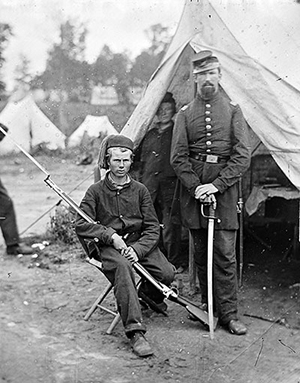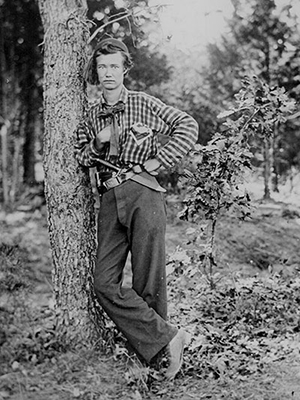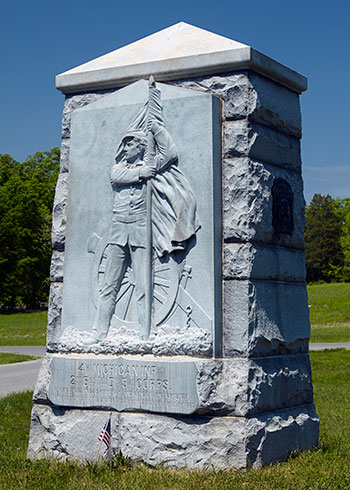- Description of battles it served in
- Links to any other web sites with information about it
- List of any books or other reading sources relevant to the unit
- Link to any Living History group, Fraternal organization or Roundtable related to it
- Any photos of the original members we are allowed to post here
History of the 4th Michigan Infantry
Text by Jeremy Bevard
 The 4th Michigan Infantry was mustered into service in Adrian Michigan on June 20th, 1861 with 1025 men including officers. It was then sent to the seat of war near Washington to join up with the Army of the Potomac. The men of the Fourth saw extensive action during the Peninsula campaign in 1862. The Regiment was present at the siege of Yorktown, Williamsburg and Newbridge. The men more than saw the elephant with fighting at Hanover Courthouse, Battle of New Bridge, Mechanicsville, Gaines Mill and Malvern Hill. During this campaign the 4th Michigan suffered 263 casualties but the year was not over yet.
The 4th Michigan Infantry was mustered into service in Adrian Michigan on June 20th, 1861 with 1025 men including officers. It was then sent to the seat of war near Washington to join up with the Army of the Potomac. The men of the Fourth saw extensive action during the Peninsula campaign in 1862. The Regiment was present at the siege of Yorktown, Williamsburg and Newbridge. The men more than saw the elephant with fighting at Hanover Courthouse, Battle of New Bridge, Mechanicsville, Gaines Mill and Malvern Hill. During this campaign the 4th Michigan suffered 263 casualties but the year was not over yet.
In the fall of 1862 the fourth was held in reserve during the battle of Antietam and was part of the 5th Corps that went in pursuit of the Army of Northern Virginia. Here they fought at Shepardstown Ford crossing it several times. They were given orders to cross the river there and capture enemy artillery that was firing on the 5th Corps. As they ford the river rebel bullets zipped above their heads without finding their mark. Once across, the Fourth’s attack is successful in capturing four confederate artillery pieces and with driving the opposing infantry back. With darkness settling in they head back across the river. Early the next morning they are ordered to pick up any rebel stragglers and bring them back. The following morning the 118th Pennsylvania is ordered to cross right about the time the Confederates counter attack. The Pennsylvania boys take very heavy casualties before the survivors make it back across as the 4th Michigan is coming to the river to hold the pursuing enemy at the ford. The holding action is successful and brings an end to the pursuit of the Confederates after Antietam. But the year was not over and before it closed the 4th Michigan would once again see fighting at Fredericksburg and take another 14 casualties. This was a small price compared to the two-thirds of the Irish Brigade they watched fall who fought on their right.
The year 1863 started quiet for the 4th Michigan and is slow to start but in May they are involved in the fighting at Chancellorsville taking about 30 casualties. Not long after the 4th Michigan starts moving north with the rest of the Army toward their fate at Gettysburg. Colonel Jeffords, commanding the Regiment, said when his men stepped on the soil of Pennsylvania they gave a deafening Wolverine cheer. Their action at Gettysburg on July second would forever change the regiment. The 4th Michigan went into the Wheatfield at a time when the Union forces under Zook were overrun leaving the Fourth’s flank unprotected. The regiment became surrounded. In the retreat, Colonel Jeffords rallied the men to save their flag, which was being captured. As Jeffords attempted to reclaim the flag the enemy bayoneted him. The next day the colonel died of his wounds at the age of 26. He would be the only field officer bonneted on either side during the war. Sadly his efforts were not successful as the flag was lost in the close combat fighting that took place in the Wheatfield. However, the attack was able to slow the Confederate advance across the area. The 4th Michigan at Gettysburg suffered another terrible 165 men lost to wounds, missing and killed during this horrific three-day battle.
The rest of 1863 the men spent much time on picket duty and near the end of the year talk of whether to reenlist or not were buzzed through the Regiment. While these discussions were taking place the men left in late November for the Mine Run Campaign. The men were to attack Lee who was behind strong defenses. The men lay under arms, freezing, waiting for the order to go on what they all knew was a suicide attack. Thankfully the generals in charge realized what all the men in the ranks had already figured out and the attack was called off.
On December 6th, 1863 the 4th Michigan along with the rest of the 5th Corps, First Division, Second Brigade arrived near Bealton Station, VA to set up winter quarters. It took some of the men just four days to finish their cabins which included a fireplace and bunks. Some of the officers lived in cabins their men built for them which were 9 foot by 11 foot with canvas roofs. One officer wrote his cabin included a fireplace, stone chimney, some furniture and a door. Their only duty during December was to guard supplies at a depot. Since Colonel Jeffords death the Regiment was still under command of Lt Colonel George Lumbard who during this downtime started to pen letters to become a colonel and continue to command the 4th Michigan. On December 20th Major Jarus Hall read the assembled men orders about reenlistment and that they would receive a bounty, 30 days furlough and be designated “Veteran Volunteers” if a majority signed on for another three years. The response was mixed and on Christmas just 20 men had reenlisted. The Lt Colonel and Major tried to further create excitement in reenlistment by offering a party to those that did that would include plenty of whiskey. One such party did take place on December 29th. 
The year of 1864 opened with the reenlistment question still hanging in the air. In the end about 150 of the men did not reenlist as they felt they had done their duty and it was someone else’s time to serve. Almost an equal number did reenlist. For those men, they left for Michigan on February 25th to start their furlough. Once the men returned they didn’t have to wait long for the next campaign to begin. By the end of April the Army was getting ready to march towards one of its toughest campaigns yet under the direction of General Ulysses Grant.
May would start with the Battle of the Wilderness. It was a costly one for the regiment as by the end they had fewer then 200 still standing. There was no time for rest as the fight at Spotsylvania Courthouse was just a few days later. By May 8th the senior most officer still with the regiment was Captain David Marshall who took command of what was left. On May 15th they received additional men that brought them back up to about 200 present for duty. The fighting carried on into June with Cold Harbor as Grant continued to drive the Confederate Army further south toward Richmond. Eventually, meeting them around the defenses at Petersburg, VA. Here on June 19th those original men that did not reenlist were able to start for home. What was left of the Fourth was enough to be an effect unit any longer because of the casualties in May and June. They were combined with the 1st Michigan Infantry essentially bring an end to the 4th Michigan as it had existed for the last three years.
 Major Jarius Hall, now Colonel, started to recruit for a reorganized 4th Michigan back home in the summer and fall of 1864. However, this new regiment, with a few of the original men who changed their minds, would be sent west instead of east. The old 4th serving in the 1st Michigan thought for sure they would join this new unit. But they received notice that they would not be transferred to join the reorganized 4th Michigan. During the rest of the year the old 4th Michigan in with the First continued to stay outside Petersburg in trenches. They spent this time digging, building, skirmishing and keeping their heads down. They would see action again at Five Forks before being at Appomattox Courthouse for the surrender of Lee in April 1865. They went to Washington to march in the Grand Review but did not get to go home as many other units did.
Major Jarius Hall, now Colonel, started to recruit for a reorganized 4th Michigan back home in the summer and fall of 1864. However, this new regiment, with a few of the original men who changed their minds, would be sent west instead of east. The old 4th serving in the 1st Michigan thought for sure they would join this new unit. But they received notice that they would not be transferred to join the reorganized 4th Michigan. During the rest of the year the old 4th Michigan in with the First continued to stay outside Petersburg in trenches. They spent this time digging, building, skirmishing and keeping their heads down. They would see action again at Five Forks before being at Appomattox Courthouse for the surrender of Lee in April 1865. They went to Washington to march in the Grand Review but did not get to go home as many other units did.
The reorganized 4th Michigan went west and spent the rest of 1864 into 1865 marching and camping around Nashville and Knoxville Tennessee when the war ended. They thought they would go home but were instead transferred to New Orleans. The reunion of the old and new 4th Michigan took place in June 1865 in New Orleans. One veteran jokingly wrote it was “a pleasure ride of about 2400 miles.” The journey was still not over as concerns of Indian attacks and Confederate activity in Mexico sent them into Texas. The time passed slowly as they moved around central Texas. By May 1866 over 100 men had deserted and three times that number had been discharged for disability along with many dying from disease.
The end finally came for the remaining 235 men when they started a two-week trip to Detroit. The reorganized 4th Michigan arrived on June 10th, 1866 and was sent to the barracks at Fort Wayne, Detroit. They were mustered out of service on June 12th, 1866.
References:
The 4th Michigan Infantry in the Civil War by Martin Bertera and Kim Crawford
www.4thmichigan.com built and maintained by George Wilkinson
Organization on the 4th Michigan
Organized at Adrian, Mich., and mustered in June 20, 1861.
Left State for Washington, D.C., June 26.
Attached to Wilcox's Brigade, Heintzelman's Division, McDowell's Army of Northeastern Virginia, to August, 1861.
Sherman's Brigade, Division of the Potomac, to October, 1861.
Morell's Brigade, Porter's Division, Army of the Potomac, to March, 1862.
2nd Brigade, 1st Division, 3rd Army Corps, Army of the Potomac, to May, 1862.
2nd Brigade, 1st Division, 5th Army Corps, Army of the Potomac, to June, 1864.
After Re-organization -
Organized at Adrian and Hudson, Mich., and mustered in October 14, 1864.
Left State for Nashville, Tenn., October 22; thence moved to Decatur, Ala., October 26.
Attached to District of Northern Alabama, Dept. of the Cumberland, to November, 1864.
1st Brigade. Defences of the Nashville & Chattanooga Railroad, Dept. of the Cumberland, to January, 1865.
3rd Brigade, 3rd Division, 4th Army Corps, Army of the Cumberland, to June, 1865.
2nd Brigade, 3rd Division, 4th Army Corps, to August. 1865.
Dept. of Texas to May, 1866.
Roster of Men of the 4th - Links to Photos of Men where known - Coming Soon
| Field and Staff | Company A | Company B | Company C |
| Company D | Company E | Company F | Company G |
| Company H | Company I | Company K | Unassigned Men |
Links Related to the 4th Michigan
4th Michigan History Website |
Built and maintained by George Wilkinson, this is an excellent, on-line source for information about the 4th Michigan Infantry. | www.4thmichigan.com |
| 4th Michigan Flag Information | The 4th Michigan is well represented in the flags that survive. Follow this link to go to the section of our Flags page about the 4th Michigan Infantry. Besides National and Regimental colors, there is also a flag from one of the militia companies that comprised the 4th. This is quite unique! | 4th Michigan Flags |
| 4th Michigan Gettyburg Monument | Follow this link to our page about the Michigan monuments at Gettysburg. This link will take you directly to the section on the 4th Michigan Infantry. | 4th Michigan Infantry Gettysburg Monument |
| 12th South Carolina/4th Michigan, Company I | This group portrays primarily the 12th South Carolina, though they also portray the 4th Michigan when needed. There is excellent information here on both regiments! | http://www.civilwarlives.org/ |
Books about the 4th Michigan
| The 4th Michigan in the Civil War - by Martin N. Bertera and Kim Crawford | A book about the actions of the 4th Michigan. Published by Michigan State University Press in 2010. Hardcover. | |
| The 4th Michigan Infantry at the Battle of Wheatfield - by Martin Bertera | A smaller work on the 4th in it's action at Gettysburg. Colonel Jeffords was killed by a bayonet wound in this fight. Published by Morningside Press in 1997 | |
| The 4th Michigan at the Battle of New Bridge Va. - by Martin Bertera | ||
| Small Arms Used by Michigan Troops in the Civil War | Part of a collection of books was released by Michigan's Centennial Observence Commission during the Centennial in the 1960s. There is a segment in this book about the weapons the 4th used. | |
Michigan at Antietam - By Brian James Egen and Jack Dempsey |
America's single bloodiest day was at the Battle of Antietam, and Michigan played a prominent role. Discover the state's connections to the Lost Order, one of the Civil War's greatest mysteries. Explore George A. Custer's role as a staff officer in combat. Mourn the extraordinary losses Michiganders suffered, including one regiment losing nearly half its strength at the epicenter of the battle. The Wolverine State's contributions to secure the Union and enable the Emancipation Proclamation are vast and worthy of a monument on the battlefield. | |